Organizational Behaviors: Attitude Shifts and Cultural Impacts
VerifiedAdded on 2023/01/05
|7
|1925
|78
Report
AI Summary
This report examines the dynamic relationship between changing attitudes and organizational culture in the workplace, drawing on research from the past two decades. It explores how factors such as increased social media use, generational differences, technological advancements, and demographic shifts have altered employee behaviors and expectations. The report analyzes how these attitude changes impact organizational culture, specifically focusing on concepts like unlearning, decision-making processes, and the influence of human emotions, such as anger. The analysis integrates insights from academic articles on perspective-taking, attainment versus maintenance goals, and unlearning, offering a comprehensive view of how organizations must adapt to these evolving dynamics to maintain a positive and productive work environment. The report emphasizes the importance of understanding these changes to ensure that organizational culture effectively reflects the evolving needs and behaviors of employees, ultimately contributing to organizational success. The report highlights the need for leadership to consider the views of all workers to adopt a strong organizational culture.
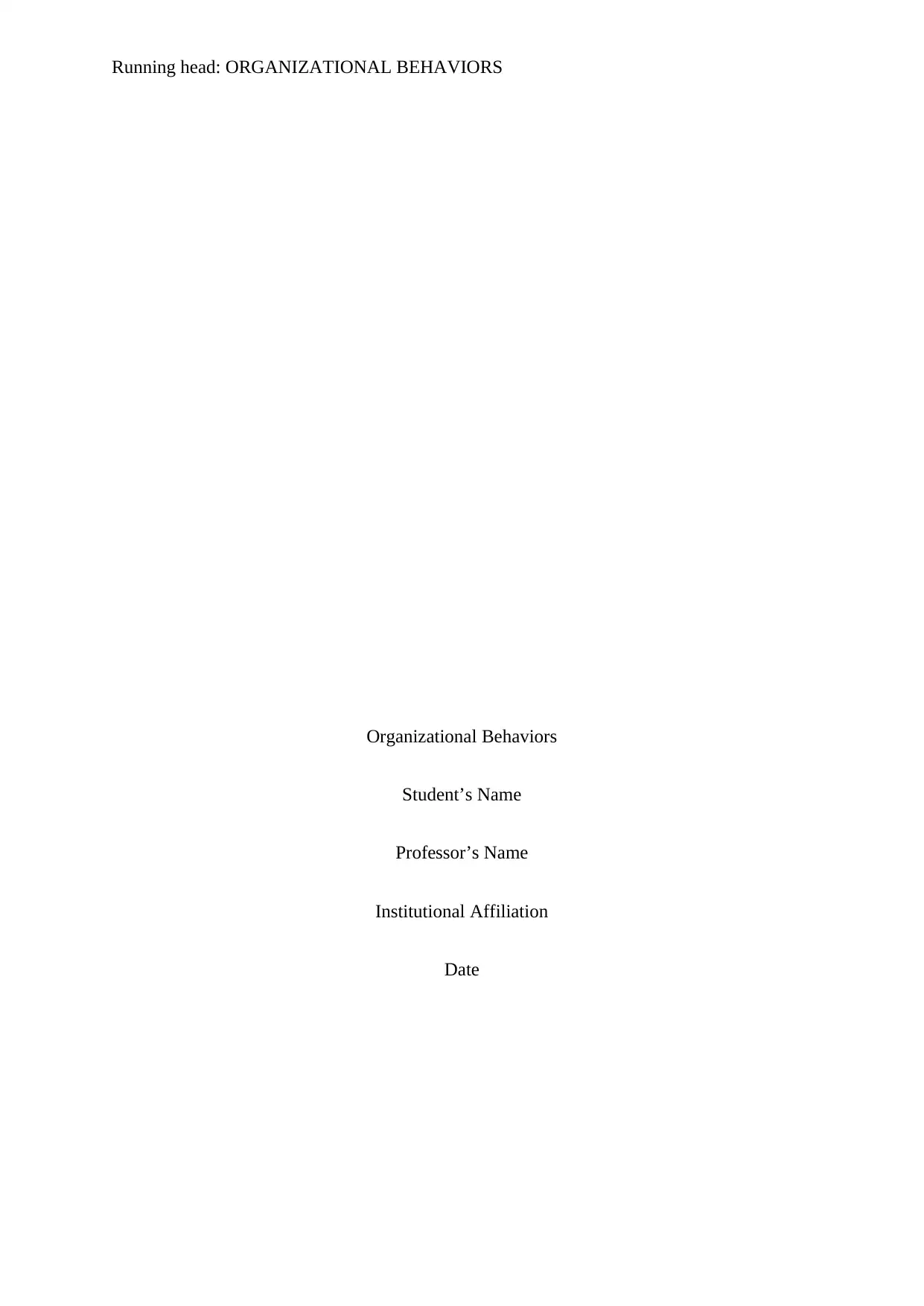
Running head: ORGANIZATIONAL BEHAVIORS
Organizational Behaviors
Student’s Name
Professor’s Name
Institutional Affiliation
Date
Organizational Behaviors
Student’s Name
Professor’s Name
Institutional Affiliation
Date
Paraphrase This Document
Need a fresh take? Get an instant paraphrase of this document with our AI Paraphraser
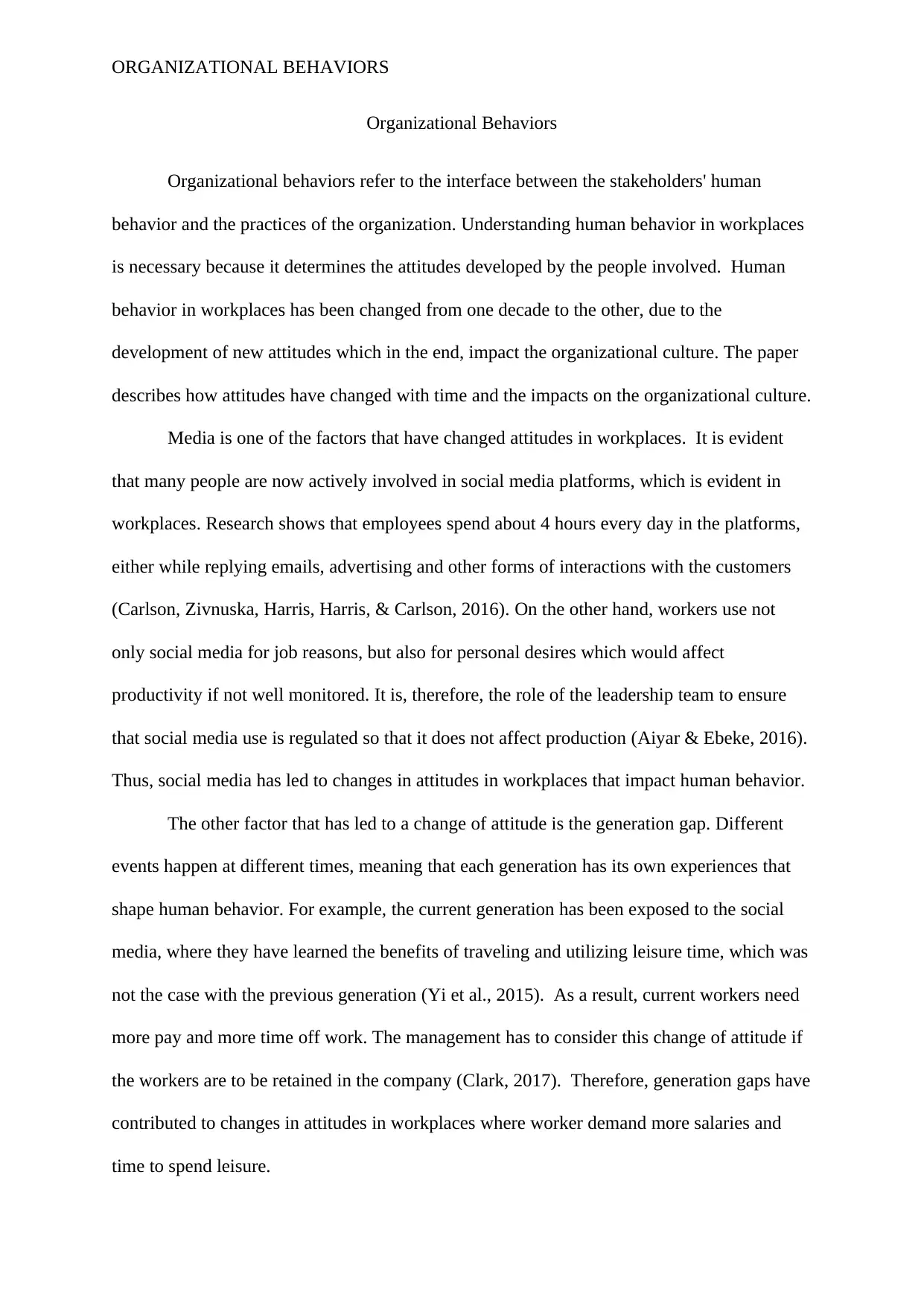
ORGANIZATIONAL BEHAVIORS
Organizational Behaviors
Organizational behaviors refer to the interface between the stakeholders' human
behavior and the practices of the organization. Understanding human behavior in workplaces
is necessary because it determines the attitudes developed by the people involved. Human
behavior in workplaces has been changed from one decade to the other, due to the
development of new attitudes which in the end, impact the organizational culture. The paper
describes how attitudes have changed with time and the impacts on the organizational culture.
Media is one of the factors that have changed attitudes in workplaces. It is evident
that many people are now actively involved in social media platforms, which is evident in
workplaces. Research shows that employees spend about 4 hours every day in the platforms,
either while replying emails, advertising and other forms of interactions with the customers
(Carlson, Zivnuska, Harris, Harris, & Carlson, 2016). On the other hand, workers use not
only social media for job reasons, but also for personal desires which would affect
productivity if not well monitored. It is, therefore, the role of the leadership team to ensure
that social media use is regulated so that it does not affect production (Aiyar & Ebeke, 2016).
Thus, social media has led to changes in attitudes in workplaces that impact human behavior.
The other factor that has led to a change of attitude is the generation gap. Different
events happen at different times, meaning that each generation has its own experiences that
shape human behavior. For example, the current generation has been exposed to the social
media, where they have learned the benefits of traveling and utilizing leisure time, which was
not the case with the previous generation (Yi et al., 2015). As a result, current workers need
more pay and more time off work. The management has to consider this change of attitude if
the workers are to be retained in the company (Clark, 2017). Therefore, generation gaps have
contributed to changes in attitudes in workplaces where worker demand more salaries and
time to spend leisure.
Organizational Behaviors
Organizational behaviors refer to the interface between the stakeholders' human
behavior and the practices of the organization. Understanding human behavior in workplaces
is necessary because it determines the attitudes developed by the people involved. Human
behavior in workplaces has been changed from one decade to the other, due to the
development of new attitudes which in the end, impact the organizational culture. The paper
describes how attitudes have changed with time and the impacts on the organizational culture.
Media is one of the factors that have changed attitudes in workplaces. It is evident
that many people are now actively involved in social media platforms, which is evident in
workplaces. Research shows that employees spend about 4 hours every day in the platforms,
either while replying emails, advertising and other forms of interactions with the customers
(Carlson, Zivnuska, Harris, Harris, & Carlson, 2016). On the other hand, workers use not
only social media for job reasons, but also for personal desires which would affect
productivity if not well monitored. It is, therefore, the role of the leadership team to ensure
that social media use is regulated so that it does not affect production (Aiyar & Ebeke, 2016).
Thus, social media has led to changes in attitudes in workplaces that impact human behavior.
The other factor that has led to a change of attitude is the generation gap. Different
events happen at different times, meaning that each generation has its own experiences that
shape human behavior. For example, the current generation has been exposed to the social
media, where they have learned the benefits of traveling and utilizing leisure time, which was
not the case with the previous generation (Yi et al., 2015). As a result, current workers need
more pay and more time off work. The management has to consider this change of attitude if
the workers are to be retained in the company (Clark, 2017). Therefore, generation gaps have
contributed to changes in attitudes in workplaces where worker demand more salaries and
time to spend leisure.
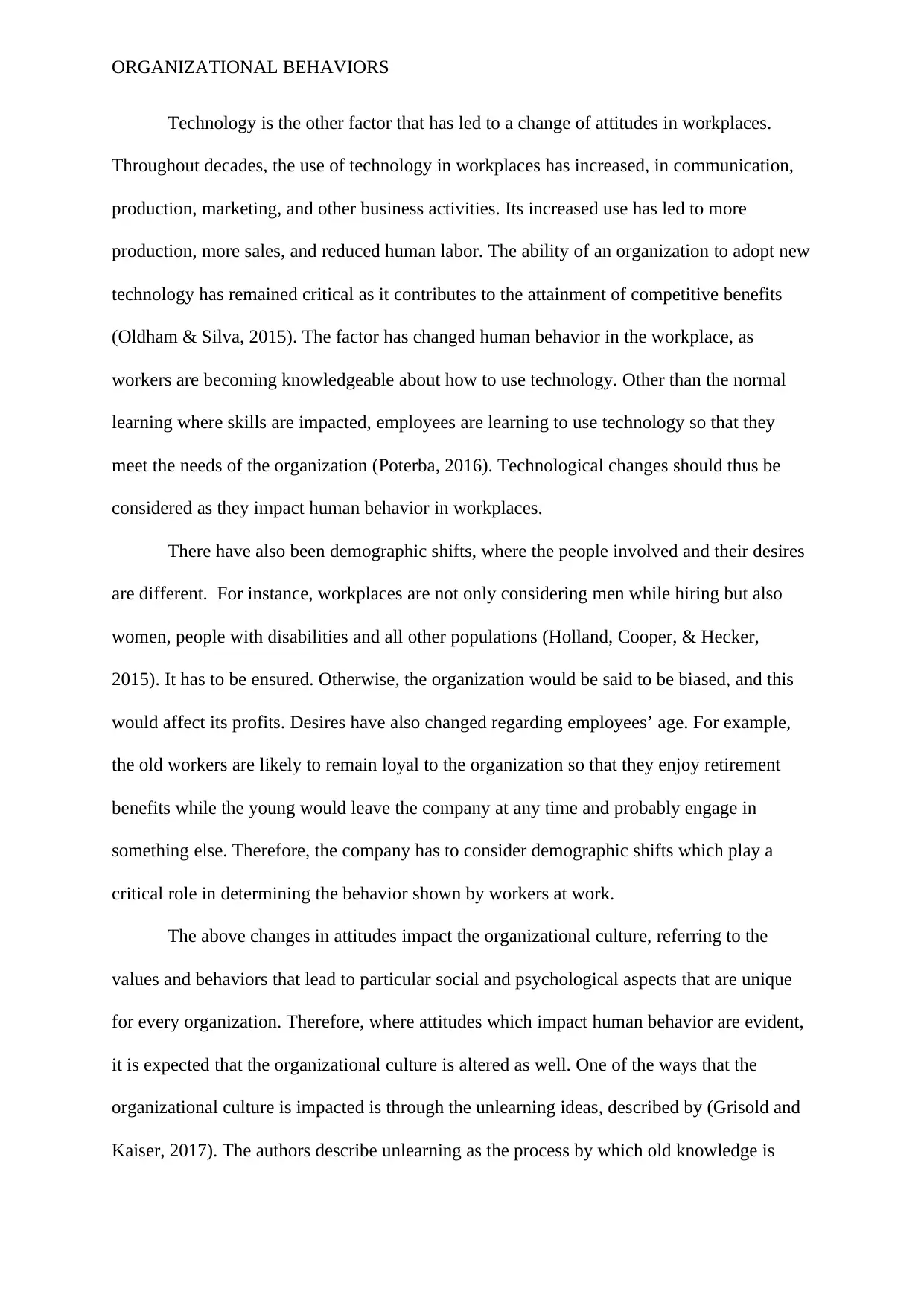
ORGANIZATIONAL BEHAVIORS
Technology is the other factor that has led to a change of attitudes in workplaces.
Throughout decades, the use of technology in workplaces has increased, in communication,
production, marketing, and other business activities. Its increased use has led to more
production, more sales, and reduced human labor. The ability of an organization to adopt new
technology has remained critical as it contributes to the attainment of competitive benefits
(Oldham & Silva, 2015). The factor has changed human behavior in the workplace, as
workers are becoming knowledgeable about how to use technology. Other than the normal
learning where skills are impacted, employees are learning to use technology so that they
meet the needs of the organization (Poterba, 2016). Technological changes should thus be
considered as they impact human behavior in workplaces.
There have also been demographic shifts, where the people involved and their desires
are different. For instance, workplaces are not only considering men while hiring but also
women, people with disabilities and all other populations (Holland, Cooper, & Hecker,
2015). It has to be ensured. Otherwise, the organization would be said to be biased, and this
would affect its profits. Desires have also changed regarding employees’ age. For example,
the old workers are likely to remain loyal to the organization so that they enjoy retirement
benefits while the young would leave the company at any time and probably engage in
something else. Therefore, the company has to consider demographic shifts which play a
critical role in determining the behavior shown by workers at work.
The above changes in attitudes impact the organizational culture, referring to the
values and behaviors that lead to particular social and psychological aspects that are unique
for every organization. Therefore, where attitudes which impact human behavior are evident,
it is expected that the organizational culture is altered as well. One of the ways that the
organizational culture is impacted is through the unlearning ideas, described by (Grisold and
Kaiser, 2017). The authors describe unlearning as the process by which old knowledge is
Technology is the other factor that has led to a change of attitudes in workplaces.
Throughout decades, the use of technology in workplaces has increased, in communication,
production, marketing, and other business activities. Its increased use has led to more
production, more sales, and reduced human labor. The ability of an organization to adopt new
technology has remained critical as it contributes to the attainment of competitive benefits
(Oldham & Silva, 2015). The factor has changed human behavior in the workplace, as
workers are becoming knowledgeable about how to use technology. Other than the normal
learning where skills are impacted, employees are learning to use technology so that they
meet the needs of the organization (Poterba, 2016). Technological changes should thus be
considered as they impact human behavior in workplaces.
There have also been demographic shifts, where the people involved and their desires
are different. For instance, workplaces are not only considering men while hiring but also
women, people with disabilities and all other populations (Holland, Cooper, & Hecker,
2015). It has to be ensured. Otherwise, the organization would be said to be biased, and this
would affect its profits. Desires have also changed regarding employees’ age. For example,
the old workers are likely to remain loyal to the organization so that they enjoy retirement
benefits while the young would leave the company at any time and probably engage in
something else. Therefore, the company has to consider demographic shifts which play a
critical role in determining the behavior shown by workers at work.
The above changes in attitudes impact the organizational culture, referring to the
values and behaviors that lead to particular social and psychological aspects that are unique
for every organization. Therefore, where attitudes which impact human behavior are evident,
it is expected that the organizational culture is altered as well. One of the ways that the
organizational culture is impacted is through the unlearning ideas, described by (Grisold and
Kaiser, 2017). The authors describe unlearning as the process by which old knowledge is
⊘ This is a preview!⊘
Do you want full access?
Subscribe today to unlock all pages.

Trusted by 1+ million students worldwide
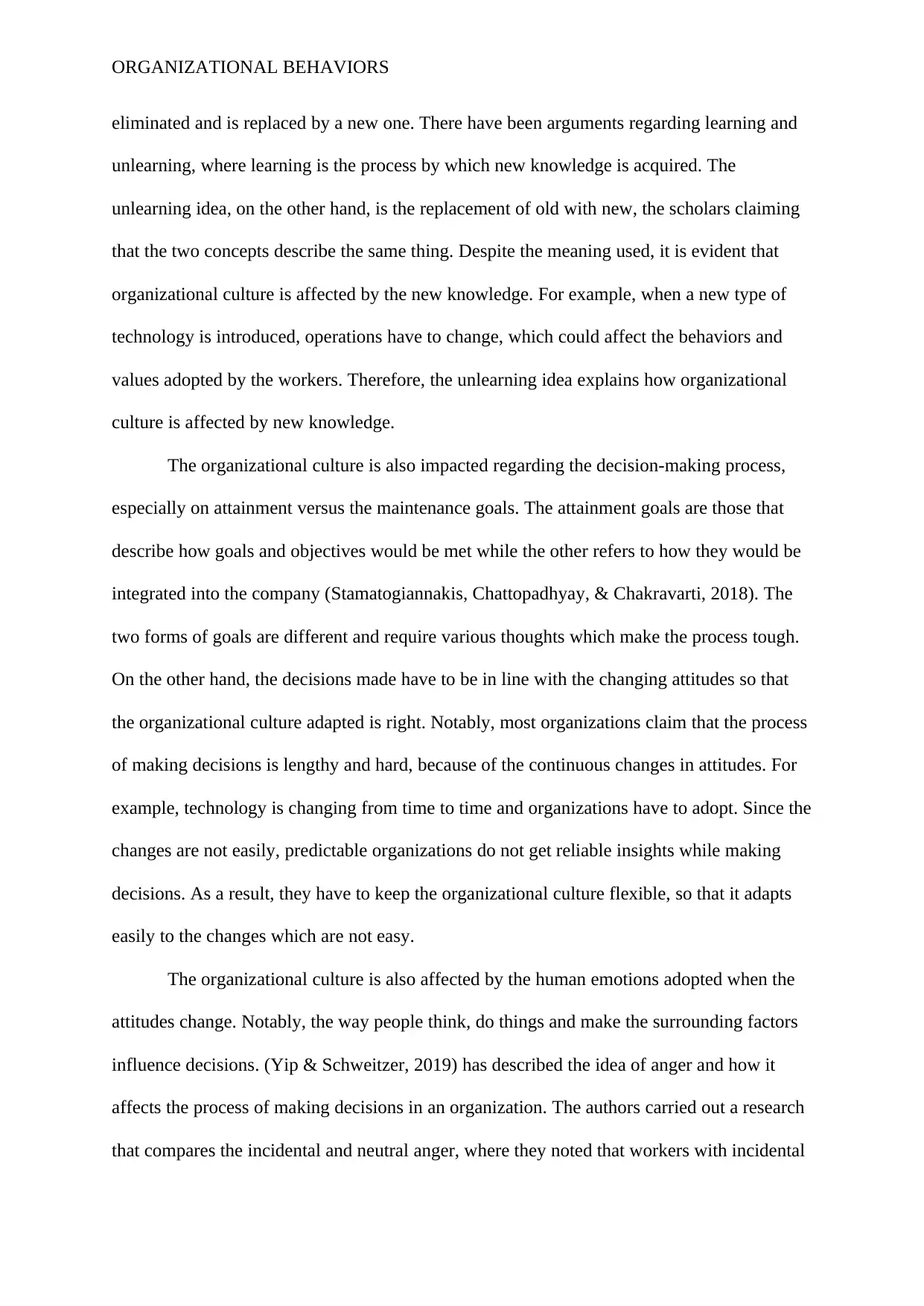
ORGANIZATIONAL BEHAVIORS
eliminated and is replaced by a new one. There have been arguments regarding learning and
unlearning, where learning is the process by which new knowledge is acquired. The
unlearning idea, on the other hand, is the replacement of old with new, the scholars claiming
that the two concepts describe the same thing. Despite the meaning used, it is evident that
organizational culture is affected by the new knowledge. For example, when a new type of
technology is introduced, operations have to change, which could affect the behaviors and
values adopted by the workers. Therefore, the unlearning idea explains how organizational
culture is affected by new knowledge.
The organizational culture is also impacted regarding the decision-making process,
especially on attainment versus the maintenance goals. The attainment goals are those that
describe how goals and objectives would be met while the other refers to how they would be
integrated into the company (Stamatogiannakis, Chattopadhyay, & Chakravarti, 2018). The
two forms of goals are different and require various thoughts which make the process tough.
On the other hand, the decisions made have to be in line with the changing attitudes so that
the organizational culture adapted is right. Notably, most organizations claim that the process
of making decisions is lengthy and hard, because of the continuous changes in attitudes. For
example, technology is changing from time to time and organizations have to adopt. Since the
changes are not easily, predictable organizations do not get reliable insights while making
decisions. As a result, they have to keep the organizational culture flexible, so that it adapts
easily to the changes which are not easy.
The organizational culture is also affected by the human emotions adopted when the
attitudes change. Notably, the way people think, do things and make the surrounding factors
influence decisions. (Yip & Schweitzer, 2019) has described the idea of anger and how it
affects the process of making decisions in an organization. The authors carried out a research
that compares the incidental and neutral anger, where they noted that workers with incidental
eliminated and is replaced by a new one. There have been arguments regarding learning and
unlearning, where learning is the process by which new knowledge is acquired. The
unlearning idea, on the other hand, is the replacement of old with new, the scholars claiming
that the two concepts describe the same thing. Despite the meaning used, it is evident that
organizational culture is affected by the new knowledge. For example, when a new type of
technology is introduced, operations have to change, which could affect the behaviors and
values adopted by the workers. Therefore, the unlearning idea explains how organizational
culture is affected by new knowledge.
The organizational culture is also impacted regarding the decision-making process,
especially on attainment versus the maintenance goals. The attainment goals are those that
describe how goals and objectives would be met while the other refers to how they would be
integrated into the company (Stamatogiannakis, Chattopadhyay, & Chakravarti, 2018). The
two forms of goals are different and require various thoughts which make the process tough.
On the other hand, the decisions made have to be in line with the changing attitudes so that
the organizational culture adapted is right. Notably, most organizations claim that the process
of making decisions is lengthy and hard, because of the continuous changes in attitudes. For
example, technology is changing from time to time and organizations have to adopt. Since the
changes are not easily, predictable organizations do not get reliable insights while making
decisions. As a result, they have to keep the organizational culture flexible, so that it adapts
easily to the changes which are not easy.
The organizational culture is also affected by the human emotions adopted when the
attitudes change. Notably, the way people think, do things and make the surrounding factors
influence decisions. (Yip & Schweitzer, 2019) has described the idea of anger and how it
affects the process of making decisions in an organization. The authors carried out a research
that compares the incidental and neutral anger, where they noted that workers with incidental
Paraphrase This Document
Need a fresh take? Get an instant paraphrase of this document with our AI Paraphraser
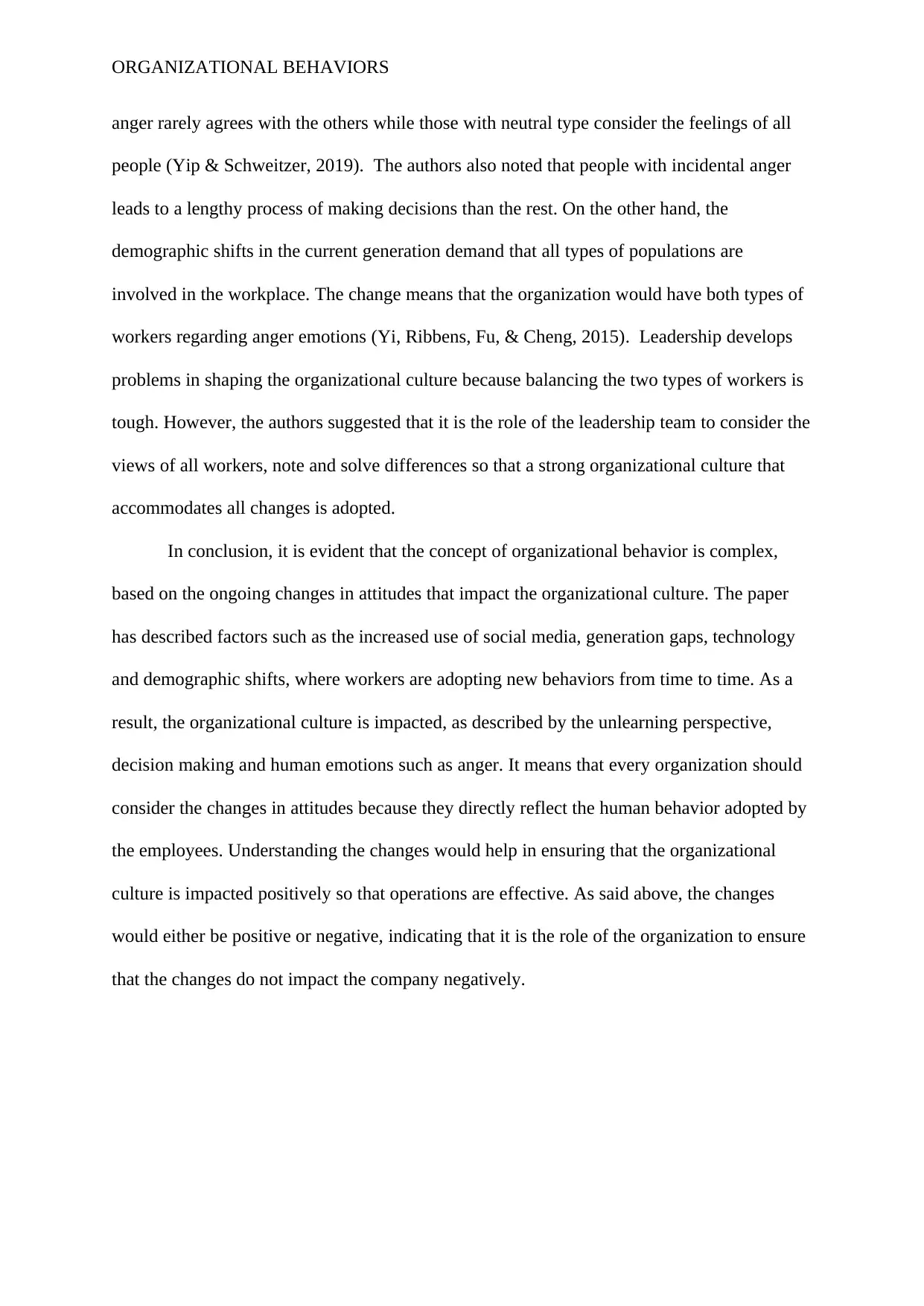
ORGANIZATIONAL BEHAVIORS
anger rarely agrees with the others while those with neutral type consider the feelings of all
people (Yip & Schweitzer, 2019). The authors also noted that people with incidental anger
leads to a lengthy process of making decisions than the rest. On the other hand, the
demographic shifts in the current generation demand that all types of populations are
involved in the workplace. The change means that the organization would have both types of
workers regarding anger emotions (Yi, Ribbens, Fu, & Cheng, 2015). Leadership develops
problems in shaping the organizational culture because balancing the two types of workers is
tough. However, the authors suggested that it is the role of the leadership team to consider the
views of all workers, note and solve differences so that a strong organizational culture that
accommodates all changes is adopted.
In conclusion, it is evident that the concept of organizational behavior is complex,
based on the ongoing changes in attitudes that impact the organizational culture. The paper
has described factors such as the increased use of social media, generation gaps, technology
and demographic shifts, where workers are adopting new behaviors from time to time. As a
result, the organizational culture is impacted, as described by the unlearning perspective,
decision making and human emotions such as anger. It means that every organization should
consider the changes in attitudes because they directly reflect the human behavior adopted by
the employees. Understanding the changes would help in ensuring that the organizational
culture is impacted positively so that operations are effective. As said above, the changes
would either be positive or negative, indicating that it is the role of the organization to ensure
that the changes do not impact the company negatively.
anger rarely agrees with the others while those with neutral type consider the feelings of all
people (Yip & Schweitzer, 2019). The authors also noted that people with incidental anger
leads to a lengthy process of making decisions than the rest. On the other hand, the
demographic shifts in the current generation demand that all types of populations are
involved in the workplace. The change means that the organization would have both types of
workers regarding anger emotions (Yi, Ribbens, Fu, & Cheng, 2015). Leadership develops
problems in shaping the organizational culture because balancing the two types of workers is
tough. However, the authors suggested that it is the role of the leadership team to consider the
views of all workers, note and solve differences so that a strong organizational culture that
accommodates all changes is adopted.
In conclusion, it is evident that the concept of organizational behavior is complex,
based on the ongoing changes in attitudes that impact the organizational culture. The paper
has described factors such as the increased use of social media, generation gaps, technology
and demographic shifts, where workers are adopting new behaviors from time to time. As a
result, the organizational culture is impacted, as described by the unlearning perspective,
decision making and human emotions such as anger. It means that every organization should
consider the changes in attitudes because they directly reflect the human behavior adopted by
the employees. Understanding the changes would help in ensuring that the organizational
culture is impacted positively so that operations are effective. As said above, the changes
would either be positive or negative, indicating that it is the role of the organization to ensure
that the changes do not impact the company negatively.
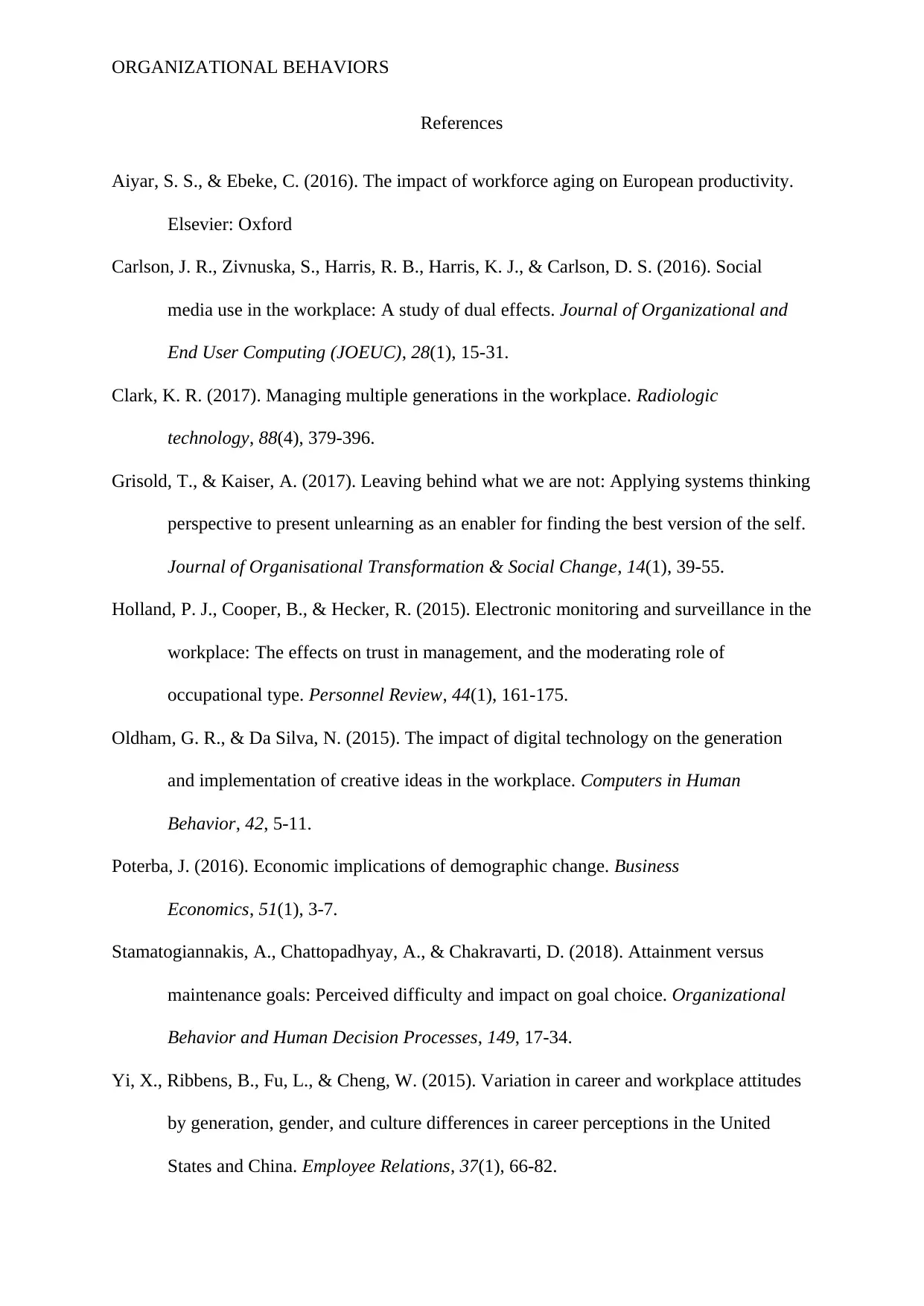
ORGANIZATIONAL BEHAVIORS
References
Aiyar, S. S., & Ebeke, C. (2016). The impact of workforce aging on European productivity.
Elsevier: Oxford
Carlson, J. R., Zivnuska, S., Harris, R. B., Harris, K. J., & Carlson, D. S. (2016). Social
media use in the workplace: A study of dual effects. Journal of Organizational and
End User Computing (JOEUC), 28(1), 15-31.
Clark, K. R. (2017). Managing multiple generations in the workplace. Radiologic
technology, 88(4), 379-396.
Grisold, T., & Kaiser, A. (2017). Leaving behind what we are not: Applying systems thinking
perspective to present unlearning as an enabler for finding the best version of the self.
Journal of Organisational Transformation & Social Change, 14(1), 39-55.
Holland, P. J., Cooper, B., & Hecker, R. (2015). Electronic monitoring and surveillance in the
workplace: The effects on trust in management, and the moderating role of
occupational type. Personnel Review, 44(1), 161-175.
Oldham, G. R., & Da Silva, N. (2015). The impact of digital technology on the generation
and implementation of creative ideas in the workplace. Computers in Human
Behavior, 42, 5-11.
Poterba, J. (2016). Economic implications of demographic change. Business
Economics, 51(1), 3-7.
Stamatogiannakis, A., Chattopadhyay, A., & Chakravarti, D. (2018). Attainment versus
maintenance goals: Perceived difficulty and impact on goal choice. Organizational
Behavior and Human Decision Processes, 149, 17-34.
Yi, X., Ribbens, B., Fu, L., & Cheng, W. (2015). Variation in career and workplace attitudes
by generation, gender, and culture differences in career perceptions in the United
States and China. Employee Relations, 37(1), 66-82.
References
Aiyar, S. S., & Ebeke, C. (2016). The impact of workforce aging on European productivity.
Elsevier: Oxford
Carlson, J. R., Zivnuska, S., Harris, R. B., Harris, K. J., & Carlson, D. S. (2016). Social
media use in the workplace: A study of dual effects. Journal of Organizational and
End User Computing (JOEUC), 28(1), 15-31.
Clark, K. R. (2017). Managing multiple generations in the workplace. Radiologic
technology, 88(4), 379-396.
Grisold, T., & Kaiser, A. (2017). Leaving behind what we are not: Applying systems thinking
perspective to present unlearning as an enabler for finding the best version of the self.
Journal of Organisational Transformation & Social Change, 14(1), 39-55.
Holland, P. J., Cooper, B., & Hecker, R. (2015). Electronic monitoring and surveillance in the
workplace: The effects on trust in management, and the moderating role of
occupational type. Personnel Review, 44(1), 161-175.
Oldham, G. R., & Da Silva, N. (2015). The impact of digital technology on the generation
and implementation of creative ideas in the workplace. Computers in Human
Behavior, 42, 5-11.
Poterba, J. (2016). Economic implications of demographic change. Business
Economics, 51(1), 3-7.
Stamatogiannakis, A., Chattopadhyay, A., & Chakravarti, D. (2018). Attainment versus
maintenance goals: Perceived difficulty and impact on goal choice. Organizational
Behavior and Human Decision Processes, 149, 17-34.
Yi, X., Ribbens, B., Fu, L., & Cheng, W. (2015). Variation in career and workplace attitudes
by generation, gender, and culture differences in career perceptions in the United
States and China. Employee Relations, 37(1), 66-82.
⊘ This is a preview!⊘
Do you want full access?
Subscribe today to unlock all pages.

Trusted by 1+ million students worldwide
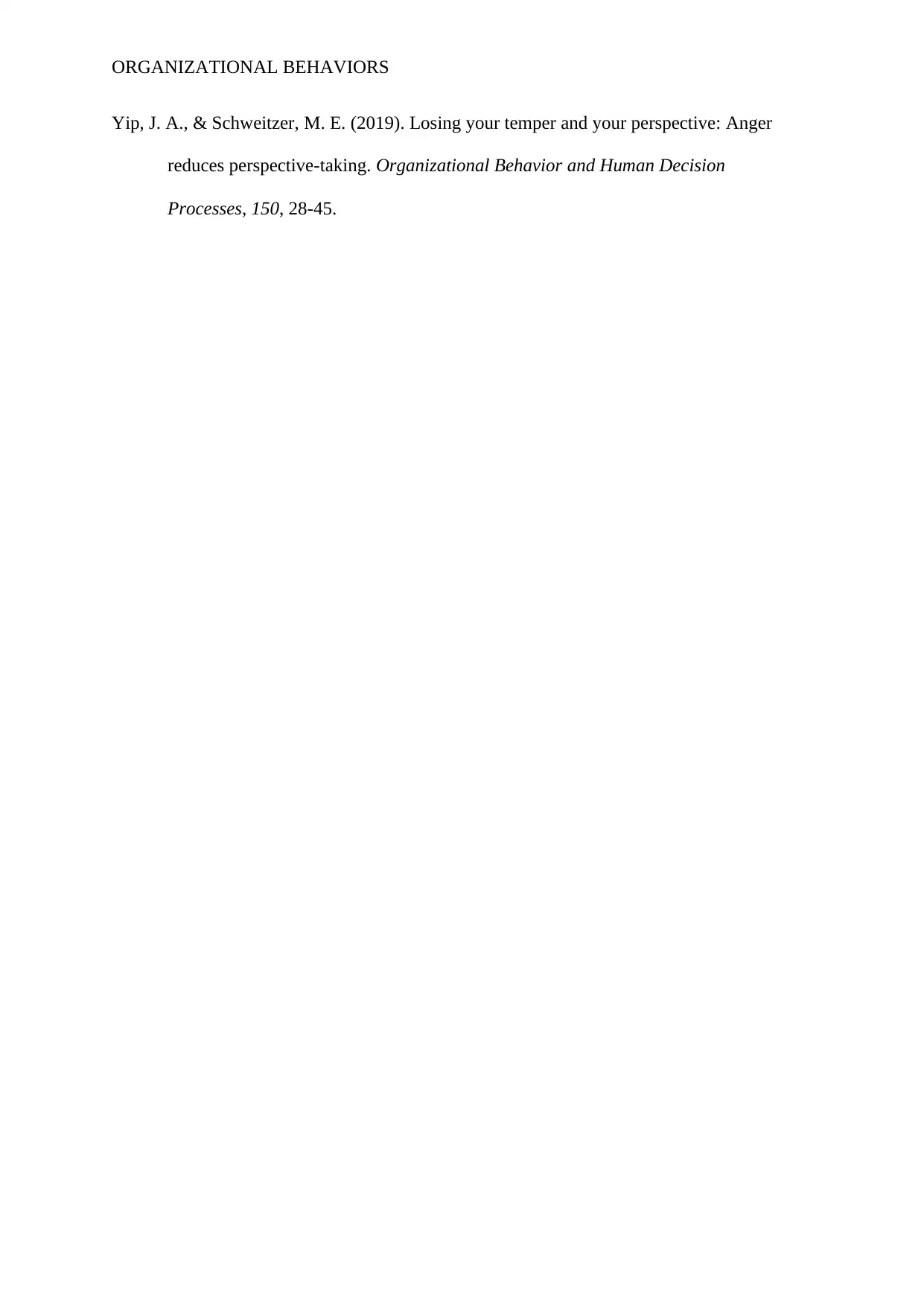
ORGANIZATIONAL BEHAVIORS
Yip, J. A., & Schweitzer, M. E. (2019). Losing your temper and your perspective: Anger
reduces perspective-taking. Organizational Behavior and Human Decision
Processes, 150, 28-45.
Yip, J. A., & Schweitzer, M. E. (2019). Losing your temper and your perspective: Anger
reduces perspective-taking. Organizational Behavior and Human Decision
Processes, 150, 28-45.
1 out of 7
Related Documents
Your All-in-One AI-Powered Toolkit for Academic Success.
+13062052269
info@desklib.com
Available 24*7 on WhatsApp / Email
![[object Object]](/_next/static/media/star-bottom.7253800d.svg)
Unlock your academic potential
Copyright © 2020–2025 A2Z Services. All Rights Reserved. Developed and managed by ZUCOL.





